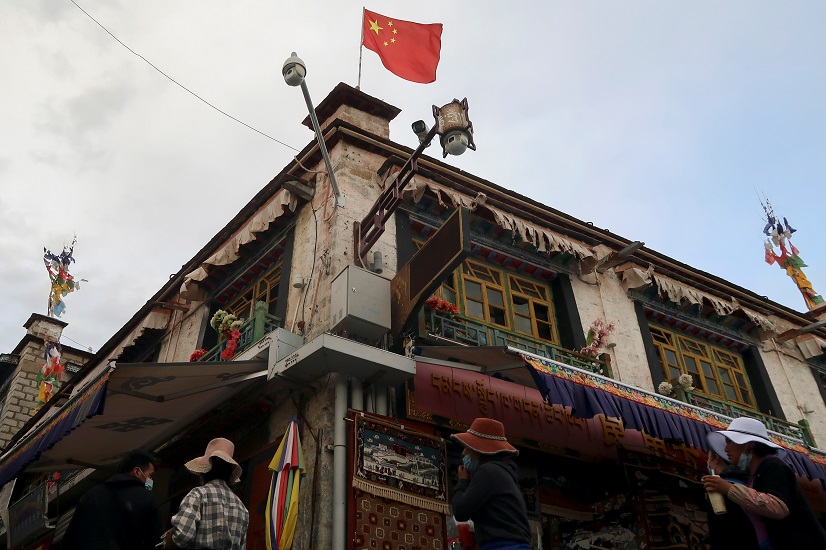Xi’s visit exposed the hollowness of China’s claim about Tibet being an ‘integral and inseparable part of China’ or that the Tibetans are ‘happy’ and ‘thankful’ to China for ‘liberation’ from the Dalai Lama’s ‘feudal’ rule.
Chinese President Xi Jinping’s sudden and dramatic visit to Tibet holds more than one meaning. And no one meaning carries less weight than the other. This is first time that Xi, the super boss of China’s most celebrated colony Tibet, since he took over the reins of China as its President, party General Secretary and the supreme military commander, visited Tibet.
The extraordinary secrecy that shrouded Xi’s sudden arrival and short stay in Tibet have, once again, exposed the Chinese establishment’s lack of faith in its Tibetan subjects and the anxiety and fears about the personal safety of its visiting supreme leader. His keen personal interest in the new railhead at Nyingchi and the progress of the ambitious Chengdu-Lhasa railway projects underlined Xi’s determination to convert Tibet into a perfectly tamed colony and his plans about increasing military pressure against India. This first ever visit of a supreme Chinese leader to demonstrate his interest in the proposed mega hydro project on the Brahmaputra is also a no less an expression of his frustration at and arrogance against India. Later his dramatic appearance in Lhasa reflected his ambition of becoming China’s supreme leader for a lifetime.
The way Xi’s visit was reported to the Tibetan people and the world community by the Chinese media two days after he landed in Nyingchi and then Lhasa, exposed the hollowness of China’s persistent claims about Tibet being an “integral and inseparable part of China” or that the Tibetans are “happy” and “thankful” to China for “liberation” from the Dalai Lama’s “feudal” rule. Reports coming from Tibet show that both Nyingchi and Lhasa were put under a near curfew like lockdown during his visit. People—except for a select crowd which was brought to greet him with well-orchestrated costume dances and handshakes in front of China’s national TV cameras in both cities—were ordered to stay indoors. For the whole time Xi was in Tibet, the streets remained under physical control of the Public Security Bureau and under the close scrutiny of thousands of security cameras—cameras that are present in every Tibetan city, town and village since Xi has taken control of China and Tibet.
This stage managed and sponsored welcome shows once again that despite seven decades of iron-fisted control over Tibet and Tibet’s people, Chinese rulers have failed to win hearts. More than 150 self-immolations by ordinary Tibetan citizens in recent years
A major point of attention for Xi in Nyingchi was the 1,629 km long Chengdu-Nyingchi-Lhasa rail project, costing $49 billion, which is going to replace the 3,000 km long Chengdu-Xining-Gormo-Lhasa-Nyingchi rail route and reduce PLA’s deployment time from 48 to just 10 hours to the Indian borders. It’s bound to further strengthen Chin’s security grip over Tibet. This development is bound to pose a fresh challenge for Indian defence forces who started linking their border posts only five years ago after the Narendra Modi government overturned earlier governments’ policy of not linking the borders with roads for fear that the Chinese would use the roads to march into Indian mainland.
Xi’s visit to Brahmaputra has reaffirmed his plans to build a complex of dams and powerhouses right on the border with India. This will have three times the capacity of the world’s largest and China’s pride, the Three Gorges Dam. If completed, it will be 111 times bigger than the Bhakhra Nangal Dam or nine times the total installed capacity of India’s top five similar projects put together. Having faced serious floods at least three times due to Chinese manipulation of rivers and dams along India’s borders, Xi’s new dreaded dam at Brahmaputra is going to be a nightmare for India.
In one of his recent speeches, Xi had announced, “To govern the country, it’s necessary to govern the border…and to govern the border, it’s required to stabilize Tibet first.” Xi’s declared aim is to become the lifelong supreme leader of China who would be armed with the power and popularity of Mao and Deng Xiaoping put together. To fulfil this dream Xi must prove his control over Tibet and dominance on the Indian borders. His surprise visit to Tibet clearly demonstrates both his anxiety as well as his determination to achieve this goal. India can neither afford to ignore Xi’s latest moves nor his designs across the border in Tibet.
Vijay Kranti is a senior Indian journalist and a keen Tibet-China watcher. He is Chairman, Centre for Himalayan Asia Studies and Engagement, New Delhi.

